Miocene - Study guides, Class notes & Summaries
Looking for the best study guides, study notes and summaries about Miocene? On this page you'll find 51 study documents about Miocene.
All 51 results
Sort by

-
Anthropology 105 Exam 3 Latest Update Graded A+
- Exam (elaborations) • 25 pages • 2024
- Available in package deal
-
- $9.99
- + learn more
Anthropology 105 Exam 3 Latest Update Graded A+ Chronology of Hominin Evolution: Miocene (23 - 5 m.y.a.) (Tertiary Period) Chronology of Hominin Evolution: Pleistocene (2 m.y.a. to 10,000 BP) (Ice ages) Chronology of Hominin Evolution: Recent (10,000 BP to present The most important epochs for study of hominin evolution are the? Miocene, Pleistocene, Recent Hominin: Term Term hominin used to designate the human line after its split from ancestral chimps Definition: Hominid...
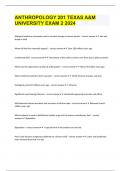
-
ANTHROPOLOGY 201 TEXAS A&M UNIVERSITY EXAM 2 2024
- Exam (elaborations) • 12 pages • 2024
-
- $16.49
- + learn more
Biological evidence commonly used to account change in human species - correct answer Size and shape of skull When did the first mammals appear? - correct answer Over 200 million years ago Continental drift - correct answer Movement of the earth's surface over time due to plate tectonics When was the appearance of diurnal anthropoids? - correct answer About 40 million years ago What continents joined to form Laurasia? - correct answer North America, Europe, and Asia Geological pe...

-
VME Weeks 1-4|171 Questions with 100% Correct Answers | Verified | Updated 2024
- Exam (elaborations) • 19 pages • 2024
-
- $7.99
- + learn more
Paleocene - ️️An epoch of the Paleogene period, 65.5 to 55.8 MYA where Order Sirenia emerged from Tethytheria Eocene - ️️An epoch of the Paleogene period, 55.8 to 33.9 MYA where Pezosiren portelli and the first Mediterranean Tethys- Paratethys ancestors of sirenians emerged; much warmer climate than today Oligocene - ️️An epoch of the Paleogene period, 33.9 to 23 MYA where Family Trichechidae, Subfamily Miosireninae, Trichechinae, and Digonginae were thought to emerge, Halither...

-
ASB 222 TOP Exam Questions and CORRECT Answers
- Exam (elaborations) • 40 pages • 2024
-
- $8.99
- + learn more
Earth ageAbout 4.6 billion years Universe10 billion years PrecambrianFirst major era of geological time, extending from the origins of earth to about 600 m.y.a PaleozoicThe appearance of the first vertebrate species: fish and amphibians Mesozoic eraAround 245 mya. The age of dinosaurs CenozoicPeriod of extinction, our current era. Divided into 7 epochs: Epochs (discussed on page 4)There are 7 epochs: Holocene, pleistocene, pliocene, miocene, oligocene, eocene, and paleocene (in order f...
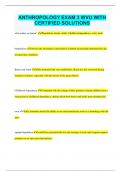
-
ANTHROPOLOGY EXAM 3 WVU WITH CERTIFIED SOLUTIONS
- Exam (elaborations) • 20 pages • 2024
- Available in package deal
-
- $9.99
- + learn more
ANTHROPOLOGY EXAM 3 WVU WITH CERTIFIED SOLUTIONS what makes us human? Bipedalism, brains, skulls, Childhood dependency, tools, teeth biopedalism stresses the advantages it provided in a habitat increasingly dominated by dry, savanna-like conditions. Brains and skulls Early hominins had very small brains, Brain size has increased during hominin evolution, especially with the advent of the genus Homo. Childhood dependency Compared with the young of other primates, human children h...
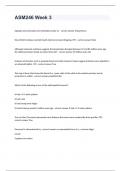
-
ASM 246 Arizona State University -asm246 week 3 correctly answered
- Exam (elaborations) • 5 pages • 2024
-
Available in package deal
-
- $9.99
- + learn more
ASM 246 Arizona State University -asm246 week 3 correctly answeredWhich of the following is considered by many to be an early anthropoid? - correct answer Eosimias True or false? Fossils of some of the earliest euprimates (i.e., true primates) have been discovered in North America - correct answer true Which of the following describes the dental formula of Aegyptopithecus from the Fayum? - correct answer 2123/2123 The ring of bone that closes the lateral (i.e., outer side) of the orbit ...

-
History of Life UPDATED Exam Questions and CORRECT Answers
- Exam (elaborations) • 10 pages • 2024
-
- $8.49
- + learn more
Era (youngest to oldest)Cenozoic, Mesozoic, Paleozoic, Proterozoic, Archean, Hadean Period (youngest to oldest)Quaternary, Neogene, Paleogene, Cretaceous, Jurassic, Triassic, Permian, Carboniferous, Devonian, Silurian, Ordovician, Cambrian, Ediacaran Epoch (youngest to oldest)Holocene, Pleistocene, Pliocene, Miocene, Oligocene, Eocene, Paleocene Principle of Superpositionolder rocks will be on the bottom while younger rocks will be on the top, can be used to get a rough estimate of time...

-
Anthropology 101 Inquisitive Chapter 9 with 100% correct answers
- Exam (elaborations) • 6 pages • 2024
-
Available in package deal
-
- $12.99
- + learn more
Anthropology 101 Inquisitive Chapter 9 Match each hypothesis about the evolution of unique primate traits to the scientist(s) who proposed it. - correct answer -Sir Grafton Elliot Smith and Frederic Wood Jones: arboreal hypothesis -Matt Cartmill: visual predation hypothesis -Robert Susan: angiosperm radiation hypothesis Match each taxonomic group of early haplorhine primates to its description. - correct answer -Propliopithecids: This is a somewhat diverse group of fossil primates. Alt...
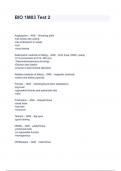
-
BIO 1M03 Test 2 Questions And Answers
- Exam (elaborations) • 8 pages • 2024
- Available in package deal
-
- $10.49
- + learn more
BIO 1M03 Test 2 Questions And Answers Angiosperm - ANS -flowering plant -has seeds with casing -has endosperm in seeds -fruit -most diverse Radiometric methods of dating - ANS -K/Ar (lava, 500K+ years) -C14 (conversion to N14, 40K yrs) -Thermoluminescence (burning) -Electron spin (teeth) -Uranium Lead (mineral deposits) Relative methods of dating - ANS -magnetic reversals -extinct and distinct species Primate - ANS -climbing/locomotion adaptations -big brain...
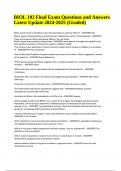
-
BIOL 102 Final Exam Questions With Correct Answers Latest Update 2024-2025 (Graded)
- Exam (elaborations) • 12 pages • 2024
-
- $11.49
- + learn more
BIOL 102 Final Exam Questions With Correct Answers Latest Update (Graded) Nine months after Krakatau errupted a spider was found on the island. Wilson suggested it arrived at the island by - ANSWER flying/ Ballooning Which species group did Wilson suggests were in dynamic equilibrium a hundred years after the erruption. - ANSWER Birds Which extinction event is associated with the disapperance of the dinosaurs? - ANSWER Cretaceous Multicelluar life is recorded in the fossil record beginnin...

That summary you just bought made someone very happy. Also get paid weekly? Sell your study resources on Stuvia! Discover all about earning on Stuvia


